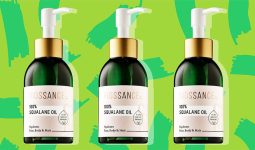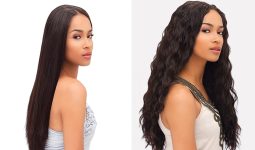What are weaves, clip-ins, pre-bonded, tape-ins, fusion, nano-tips, wigs, and hair pieces? As the world of hair extensions expands, so do the materials used for hair extensions and the styles available.
If you are new to the world of hair extensions, you must learn about many extension and term styles. We’ll break down the steps to clarify any confusion about the different extension types.
The information in this article will help you make the best choice for your hair. So relax, tie your hair back, and let’s get this started.
Synthetic Hair Extensions Vs. Real Human Hair Extensions
Before we delve into the different types of extension application methods, you should know that hair extensions come in two varieties: real human hair extensions and synthetic hair extensions.
Human hair extensions are precisely what their name implies. They are made entirely of real human hair collected from a donor.
When Remy’s hair is collected, the cuticles (hair’s outer layer) are all intact and pointing in the same direction.
This helps eliminate tangling and ensures that the extensions stay smooth and silky throughout their lifetime; synthetic hair extensions are made entirely of synthetic and blended fibers and contain no human hair.
These are typically very fine plastic fibers designed to look like natural human hair.
Looks and Feel
Different types of real and synthetic hair extension styles, colors, and application methods exist.
Synthetic fibers vary in quality, but they are generally stiff and move differently than human hair, so they do not blend well with natural hair.
To the touch, they can have a rough or coarse texture. Real hair looks and feels natural (because it is!) and blends in more naturally with your hair.
Styling & Coloring
Human hair extension types can be treated the same way as natural hair. All options are straightening, curling, blow-drying, coloring, and applying hair products.
Synthetic hair can’t be dyed because most dyes contain ammonia or bleach, which will cause it to deteriorate.
Furthermore, because heat can damage synthetic hair, you cannot style it the same way as natural hair; curling irons, straighteners, and blow dryers are out because they will melt or severely damage the hair. Sun, friction, and harsh hair products can also damage synthetic hair extension types.
Quality and Longevity of Hair Extensions
Synthetic hair is less expensive than natural hair, but there is a cost. It is not as long-lasting as human hair because it is made of synthetic fibers and is easily damaged by the factors mentioned earlier (sun, heat, etc.).
Synthetic hair extensions typically last a few months, whereas human hair extensions can last up to a year or more if properly cared for.
In conclusion, human hair can be treated and styled in the same way that your hair can, and it will appear and feel the most natural.
It will quickly blend in with your hair and last far longer than synthetic hair. Despite being less expensive than real hair, synthetic hair does not look natural, cannot be styled with heating tools, and does not last long.
Now that we’ve sorted out real vs synthetic, let’s look at the different types of extensions!
Clip-in Hair Extensions
What Exactly Are They?
Clip-in hair extensions, also called clip-in wefts, consist of contoured pieces attached at the base with fabric or silicone.
This base is equipped with clips that are ready to use. Clipping the pieces into your natural hair is as simple as that! Each clip easily opens and closes.
Clip-in extensions are the least permanent because they can be quickly removed and reapplied whenever you want.
Unlike other hair extension applications, clip-ins are typically applied at home in 5 – 15 minutes. They are also the least damaging because they do not involve chemicals, heat, pressure, or installation methods—they easily clip onto your hair, causing no damage to your natural hair.
Clip-in hair extensions are the most preferred option for people who want thicker and longer hair immediately without the hassle, long-term commitment, or financial strain. This is one of the many reasons they are one of the most popular hair extension types.
Treatment
The same rules apply to synthetic vs natural hair and to clip-in hair extensions as to other hair extensions. We’ll concentrate on human hair extensions type because they are highly recommended.
Simply put, human hair extensions require very little upkeep and should only be washed every 15-20 years, or if there is a significant build-up of product to the point where it needs to be washed or when they become unmanageable.
Just like natural hair, you brush, shampoo, and condition it before letting it air dry! You can also style Human hair clip-in extensions the same way.
They can be colored, curled, and straightened; however, when heat styling the hair, it is preferred to be used at a lower heat setting and to use a heat protectant before heat styling.
How Long Can They Be Used?
Again, this depends on how well you care for them, what products you use, and how often you wear them. Clip-ins can last three to six months or even a year, sometimes even longer, with proper care and regular wear.
Tape-in Hair Extensions
What Are They?
Tape-in extensions are another type of hair extension. As their name suggests, they are pre-taped extensions taped/glued together on each side of your hair.
Wide tape bonds hold the wefts; your hair is sandwiched between them and clamped around the strands.
A hairdresser typically applies tape-ins because they must be applied with a heated tool that heats the glue and must be aligned with the roots.
You’d also have to have them removed (using a glue remover) and then reinstalled. Naturally, applying heat to your roots and using any adhesive product, such as tape or glue, can damage your hair.
This procedure usually takes 40 minutes to an hour to complete, and if the extensions are in good condition, they can be reused.
Treatment
When installing tape-in hair extensions, you must exercise extreme caution when using conditioners or hair products, as these can cause the tape to come loose or slip off.
Hair slides off tape-ins, which is a very common problem. To ensure the glue stays on the hair, hairdressers usually recommend using special shampoo or conditioner and styling products that are less harsh and oily.
Because they are made of human hair, you can style them however you want, but keep an eye out for the roots where the glue or tape is.
How Long Can They Be Used?
Tape-ins, among the different types of extensions, are believed to be semi-permanent. They typically last 4–8 weeks before needing to be removed and reapplied.
However, it depends on how well you care for them and how quickly your hair grows, just like any other hair.
Sew-in Hair Extensions/Weave
What Are They?
Weave hair is applied by braiding natural hair into cornrows first, then using a thread and needle to sew the weave into the braids or cornrows.
Because of how they are applied, this type of extension is most commonly used on people with thicker hair. Weaving is a very time-consuming process (usually several hours).
The tight application method frequently strains the scalp and can feel heavy or uncomfortable, so it does not work well with thin or light hair.
A skilled hairdresser uses this method because it is a highly technical and challenging application that a professional must sew in.
Sew-ins are also available as wigs, sewn into wig caps similarly, but the cap comes in one piece rather than separate wefts.
Because the hair is sewn into the hair and cannot be removed, it is considered one of the most common extensions.
Treatment
If you have a weave, you should moisturize your hair’s scalp, nape, and edges at least once a week and use deep conditioning products.
Another popular recommendation for people who wear weaves is to wash their hair with a special protein product to reduce hair damage and weakness.
Regarding styling, real and synthetic hair follow the same rules because of how long they are kept in, although most of these weaves are made of real hair.
How Long Can They Be Used?
Removing the weaves every 6–8 weeks is advised, especially if you attempt to grow your hair. You must have a full weave in your hair for two months or less because it tends to affect hair growth.
Fusion & Pre-bonded Type of Extensions
What Are They?
Fusion hair extensions (bonding or pre-bonded) are attached to natural hair with adhesives like glue.
Pre-bonded hair extensions take about 3-4 hours to apply compared to other types and are also done by a hairdresser.
Fusion extensions may not be suitable for everybody because this method damages your natural hair more than sew-in, and your hairdresser may even advise against it.
The application uses a machine that resembles a hot glue gun to glue the hair to individual strands of natural hair. A heat clamp is another method of applying pre-bonded hair extensions to natural hair.
Treatment
Fusion/pre-bonded applications are maintained and cared for in the same way as natural hair. You can keep using your regular hair products, but you’ll need to reposition the extensions every 2–3 months as your natural hair grows.
Because of the numerous chemicals in the glue, this method can also cause hair loss, breakage, and scalp irritation than other different types of hair extensions.
How Long Can They Be Used?
They’re considered semi-permanent and can last up to four months in your hair. Like all the other types of extensions, this varies and depends on the type and growth of your hair.
Nano-Tip Extensions
What Are They?
Nano Tip Hair Extensions are small pre-bonded wefts of hair attached to the client’s natural hair with Nano Rings, which are 90% smaller than the majority of micro rings, producing a smooth bond.
Nano tip hair extensions are easily threaded through a Nano ring, which is clamped to your natural hair with small pliers and does not require any heat for application.
Your stylist will squeeze the Nano ring open and slide the hair extensions out to remove them. This method reduces the risk of natural hair breakage, making it another popular option among the different types of extensions.
Nano-tip hair extensions are extremely thin and light, ideal for thin or fine hair because they do not strain the natural hairline.
What is the Treatment, and How Long Does It Last?
As a general rule of thumb, nano tip extensions should be able to last 6-9 months in your hair if properly cared for.
Wigs & Hair Pieces
What Are They?
Wigs and hair pieces come in various styles and are applied topically to the hair. Long, full wigs are designed to cover your entire head (fun fact: wigs were once referred to as “head coverings” because of this).
This includes wigs with “lace fronts” or “netting”—these are different ways of making the wigs. Wigs are designed to cover the entirety of your head and replace your hair. They can be worn for various reasons, including hair loss, balding, or to change your appearance.
Hair pieces are a little different in that they are often in the shape of a bun, ponytail, or hair tie, allowing you to place them on top of your hair.
Hair pieces can be used to add thickness to a thinning area of your head, and hair must be placed on top of this section, or they are used to create a new hairstyle, such as a super long, full ponytail with only one piece to add volume.
Treatment
Wigs and hair pieces can be challenging to clean, and you must be cautious depending on whether they are real or synthetic.
Because full hair pieces are usually attached to a wig cap or other material, how you wash and treat the hair must be modified.
How Long Can They Be Used?
It depends on whether they are real or synthetic; how you care for them significantly affects their lifespan.
If you take enough care of your real human hair full wig, it can last for up to a year or more.
The smaller pieces are usually synthetic and don’t last more than a month or two in most cases, but human hair lasts longer.
And It’s as simple as that! We hope we have covered all the basic information you need to make an informed choice about which one of the different types of extensions is best for you, your hair type, and your hair goals.








